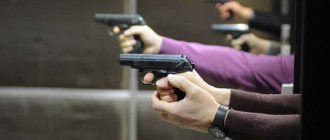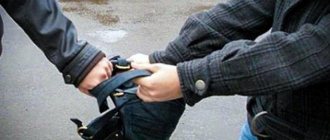One of the illegal acts provided for in Chapter 29 of the Special Part of the Criminal Code of the Russian Federation is called armed rebellion.
What is hidden behind this name for a person who reads the law for the first time? How does this act differ from any other act enshrined in the Criminal Code? Let's take a closer look. Multi-channel free hotline Legal advice on criminal law. Every day from 9.00 to 21.00
Moscow and region: +7 (495) 662-44-36
St. Petersburg: +7 (812) 449-43-40
Corpus delicti
D.N. Ushakov’s explanatory dictionary reveals the term as an armed uprising that arose as a result of a conspiracy against state power. In Italian it has a beautiful name "brolio".
Taking an excursion into the last century, you can remember 1917. The revolutionary movement that overthrew the tsarist regime of the Russian Empire is a good illustration of such an event. If similar acts occurred today, V.I. Lenin and most of the Bolsheviks joined the ranks of convicted rebels. Russia has not seen any real revolutionary movements since the 1993 putsch.
But recently, in the countries of the former CIS and other countries of the European part of the continent, revolutionary events are constantly taking place, reflected by the media. Expressing hope for a peaceful solution to vital issues in Russia, it would be useful to get an idea of the settlement of “brolio” in Russian.
What does Russian law understand by armed rebellion? It is considered to be a numerous organized uprising of people who have weapons, an attack against the legitimate state apparatus, the purpose of which is defined as changing the constitutional order or violating the territorial unity of the country.
Like other crimes, this offense includes an object (public good), an objective side (external manifestations of the event), a subject (the person performing it) and a subjective side (motives, goals, understanding of the events taking place around).
The good against which the attack is directed is the state system of the Russian Federation and its territorial integrity. In addition to the specified objects, their objects are the life and health of citizens. During a riot, they may suffer when criminals commit illegal actions.
The external manifestation of the offense is expressed in two alternative acts of the attackers:
- Organizations of the uprising.
- Active participation.
What is meant by the first paragraph? This is a set of actions that is associated with the preparation of plans and documents that constitute the platform of a new device; preliminary conspiracy of ideological masterminds; distribution of attacker roles; appeal to the masses; speaking with calls for rebellion, supplying equipment to the rebels; citizen involvement; planning government institutions in the acquired territory, as well as transferring funds for the implementation of all of the above. These single acts have one goal - to incite the masses of people to revolt with the use of weapons against the legitimate government of the country, in other words, to start a revolution.
In Art. 279 of the Criminal Code of the Russian Federation, active participation implies the commission of certain actions to forcibly seize power, aimed at its overthrow. Criminals seek to disrupt the well-being of the state using weapons.
Manifestations that are regarded as the described violation:
- Seizure of the locations of the main bodies of the state that govern the country with the use of violence against the employees located in them.
- Taking possession of communication devices, train stations, airports, highways, disrupting their activities.
- Providing resistance with the use of weapons to representatives of law enforcement.
- Agitation within the population, with calls for the overthrow of power structures.
- Intelligence data to implement revolutionary plans.
- Proclamation by violators of the law of any territorial part of a sovereign state as independent and disobedience to federal authorities.
- Supply of weapons, ammunition, equipment for the crowd.
It is suggested that even providing food and other various benefits to the rebels is also considered a manifestation of activity.
The subjective side is characterized by direct intent, that is, both the organizer and the active performer clearly understand and understand what they are doing and want the results of their illegal activities to occur.
Attackers must pursue one of the following goals:
- the overthrow of the existing constitutional system, the abolition of the rights and freedoms of citizens and the subsequent establishment of an uprising of state institutions of other forms that do not correspond to the basic law of the country;
- establishment of a new government system, change of the country's leader;
- proclamation of independence of a certain territory of the country, with the aim of establishing independent governance in this territory, not controlled by federal authorities.
The subject of this offense is an individual. By the time he commits a crime, a legally competent person must be 16 years old. A criminal case against a younger person, if he is brought under this provision of the Criminal Code of the Russian Federation, will be terminated, but the minor rebel will be held accountable for other unlawful actions committed by him in accordance with the code (an example could be liability for murder).
Article 279 of the Criminal Code of the Russian Federation contains the formal and material elements of the crime. For each type of revolutionary, the moment at which he ends his illegal acts is different. Thus, for an active participant, a violation of the law can be considered committed from the moment he performs acts pursuing the goals of the uprising.
The organizer is brought to justice by the investigative authorities only after the performance has taken place, from the moment the rioters actually leave. They must not only carry an arsenal of weapons, but also use them. In case of an unrealized offense, when the organizer did everything to implement it, but did not actually lead to a riot, the organizer will only be responsible for the preparation.
Substitution of a child (Article 153 of the Criminal Code).
Article 153 of the Criminal Code establishes criminal liability for child substitution committed for selfish or other base motives.
The danger of this crime lies in the fact that by substituting a child, blood ties of kinship are forcibly broken, and the relationship between parents and children, which is filled with deep moral universal human content, is violated.
The object of the crime in question is the interests of the family and the normal (mental and spiritual) development of the child. The victim can be either someone else's child or your own child.
From the objective side, the substitution of a child is expressed in the fact that one child is replaced by another, which is possible, as a rule, only in relation to a newborn baby, and the scene of the crime is a maternity hospital. However, substitution is also possible outside the maternity hospital. For example, replacing a child who was in a stroller on the street in the absence of adults who were with him for a walk. Child substitution has a formal composition. The crime is considered completed from the moment one child is replaced by another. Detection and suppression of a crime at the time of its commission, for example, detaining the perpetrator with a child at the scene of the substitution or in the immediate vicinity of it, is qualified as an attempted substitution.
From the subjective side, the crime provided for in Art. 153 of the Criminal Code, assumes only direct intent: the perpetrator realizes that he is committing a child substitution and wants to commit it. A mandatory feature of the subjective side of the crime provided for in Art. 153 of the Criminal Code are selfish (for compensation from interested parties) or other base motives (hooliganism, generated by racial hostility, envy, revenge, etc.). In the absence of these motives, as well as direct intent, for example, the substitution of a child, committed as a result of a careless, dishonest attitude towards their duties on the part of the medical staff of the maternity hospital, does not form a crime and is qualified as a professional misconduct.
The subject of the crime is a sane person who has reached the age of 16, in relation to whom the substitute child is a stranger. In some cases, the subject may be a parent seeking to get rid of a sick child and replacing him with another child.
Forcible seizure of power or forcible retention of power (Article 278 of the Criminal Code).
According to Art. 3 of the Constitution of the Russian Federation, no one can appropriate power in the Russian Federation. Seizure of power or appropriation of power is punishable by federal law. This norm is implemented in the article of the Criminal Code under consideration. The direct object of the violent seizure of power or the forcible retention of power is the foundations of the constitutional system, the legitimacy of the election or appointment to public office of the legislative, executive and judicial powers.
The objective side of the crime in question is characterized by actions aimed at forcibly seizing power or forcibly retaining power in violation of the Constitution of the Russian Federation, as well as aimed at forcibly changing the constitutional system of Russia.
Violent seizure of power involves the seizure of state power, mainly legislative or executive, by force, including armed means, by individuals, political groups or organizations to which power did not previously belong and which were not elected or appointed by constitutional means.
The forcible retention of power presupposes its forcible retention by persons to whom it previously belonged by law, but as a result of new elections or appointments should have passed to other persons.
A violent change in the constitutional system is understood as an actual or normative change in the provisions of the first chapter of the Constitution of the Russian Federation by unconstitutional, violent means by persons, including those who are legally or illegally in power in the country. According to Art. 134-136 of the Constitution of the Russian Federation, the foundations of the constitutional system (Chapter 1 of the Constitution) can only be revised by the Constitutional Assembly or by popular vote, if a proposal to change them is made by the President of the Russian Federation, the Federation Council, the State Duma, the Government of the Russian Federation, the legislative body of a subject of the Federation, as well as a group of at least one fifth of the members of the Federation Council or deputies of the State Duma.
The subject of a violent seizure of power, including a violent change of the constitutional system, can be any person over 16 years of age. The subject of a forcible retention of power is a former public official who, although not elected or appointed for a new term, continues to hold state power.
In accordance with the note to Art. 275 of the Criminal Code, the person who committed this act is exempt from criminal liability if he voluntarily and timely reported to the authorities or otherwise contributed to the prevention of further damage to the interests of the Russian Federation and if his actions do not contain another crime.
The subjective side of the act is characterized by direct intent. The motives for the crime do not affect the qualification of the attack.
Armed rebellion (Article 279 of the Criminal Code).
The direct object of armed rebellion is the foundations of the constitutional order, the territorial integrity of the Russian Federation, as well as the life and health of people.
The objective side of the crime is the organization of an armed rebellion or active participation in it.
The organization of an armed rebellion is understood as the organizational activity of a person or group of persons to prepare, arm and determine the tasks of the relevant people in the rebellion or the organization of the use of existing armed formations to carry it out.
Active participation in armed rebellion involves the actions of persons using weapons to achieve illegal political goals specified in the article; providing armed resistance to the authorities; use of force against government officials or other persons; armed seizure of government premises, transport communications, media, communications centers and other institutions. Death of people and other grave consequences not specified in Art. 279, as a result of the use of weapons and explosive devices during the rebellion, additional qualifications are required under Art. 105 and other articles.
The crime is completed with the commission of criminal acts; it can also be lasting.
Any person over 16 years of age can be a subject of armed rebellion.
From the subjective side, an armed rebellion can only be committed with direct intent. A mandatory sign of a person’s guilt in committing the act in question is a special motivation: committing a rebellion for the purpose of overthrowing or forcibly changing the constitutional system of the Russian Federation or for the purpose of violating the territorial integrity of the country.
Ticket No. 18
The task is to attempt to infect venereal infections. disease
Theft (Article 158 of the Criminal Code)
The law defines it as “the secret theft of someone else’s property.” The specific object of theft is property, the direct object is specific forms of ownership. The subject of theft is property[6].
From the objective side, the theft is carried out quietly and non-violently. In theory and practice, criteria have been developed, the simultaneous establishment of which gives grounds to talk about the invisibility of the theft. There are two such criteria: objective and subjective. Establishing the first of them means clarifying the attitude towards the fact of theft committed by the perpetrator on the part of those in charge or under whose protection the property is, as well as strangers (the latter, under certain circumstances, may also include relatives and close persons of the perpetrator).
First of all, theft is secret if it is committed in the absence of the owner or other owner of the property, or unauthorized persons, or in the presence of the above persons, but unnoticed by them.
When stealing in the presence of strangers, a situation is possible when these persons did not regard the actions of the perpetrator as a crime (which, in fact, was what the criminal was counting on) due to mental illness, severe intoxication, mental disability, childhood or other reasons. And here the actions of the culprit are qualified as theft.
Establishing a subjective criterion of undetectability (secret theft) involves clarifying the attitude towards the fact of the crime being committed on the part of the culprit himself. The law and judicial practice consider the subjective attribute to be decisive. Therefore, committing theft, for example, in the presence of strangers, when they mistake the culprit for the owner of the stolen property, and the culprit himself, in turn, considers his actions unnoticeable, secret, should be qualified as theft.
On the other hand, if during the commission of theft the actions of the culprit are discovered by the owner or other holder of the property or other persons, but the culprit, realizing this, continues to commit illegal seizure of property or its retention, the act should be qualified as robbery (Article 161 of the Criminal Code), and in in the case of the use of violence dangerous to life or health, or the threat of using such violence - such as robbery (Article 162 of the Criminal Code)[7].
By design, the elements of theft are material. It ends from the moment damage is caused to the owner or other possessor of the stolen property.
Theft from the subjective side is characterized by guilt in the form of direct intent and selfish purpose. The subject of the theft is a person over 14 years of age. Theft is qualified if committed:
a) by a group of persons by prior conspiracy;
b) with illegal entry into the premises or other storage;
c) causing significant damage to a citizen;
d) from clothes, bags or other hand luggage that were with the victim (Part 2 of Article 158 of the Criminal Code).
Theft committed by prior conspiracy by a group of persons should be understood as a theft in which two or more persons participated who had agreed in advance to commit it jointly. Responsibility for theft committed by a group of persons by prior conspiracy (clause “a” of Part 2 of Article 158 of the Criminal Code) occurs in cases where, according to a preliminary agreement between the accomplices, the direct seizure of property is carried out by one of them. Providing direct assistance to the perpetrator in committing a crime (for example, breaking doors, locks, bars) is co-perpetrator, which does not require reference to Art. 33 of the Criminal Code. Assisting in the commission of a crime by a person who was not directly involved in the theft, for example, by giving advice, removing obstacles, etc., should be qualified as complicity with reference to Art. 33 of the Criminal Code[8].
If theft is committed by several persons without prior conspiracy, their actions should be qualified, in the absence of qualifying features, under Part 1 of Art. 158 of the Criminal Code. When rendering a verdict, the court, if there are grounds for it, has the right to recognize the commission of a crime as part of a group of persons as an aggravating circumstance (clause “c” of Part 1 of Article 63 of the Criminal Code).
If a person has committed theft through the use of other persons who are not subject to criminal liability due to age, insanity or other circumstances, his actions, in the absence of qualifying features, should be qualified under Part 1 of Art. 158 of the Criminal Code as the direct perpetrator of the crime. The actions of a person who organized a crime or who incited a participant in the crime who is obviously not subject to criminal liability to commit it are also qualified. If there are grounds for this, the actions of these persons must be additionally qualified under Art. 150 CC.
In cases where a group of persons previously agreed to commit the theft of someone else’s property, but one of the co-perpetrators went beyond the scope of the agreement, committing actions that are subject to legal assessment as robbery or robbery, what they did should be qualified under the relevant paragraphs and parts of Art. 161, 162 of the Criminal Code[9].
Theft committed with illegal entry into a premises or other storage facility is provided for in paragraph “b” of Part 2 of Art. 158 of the Criminal Code.
The concepts of “premises” and “storage” are disclosed in Note 3 to Art. 158 of the Criminal Code. Under the premises in the articles of Ch. 21 of the Criminal Code refers to buildings and structures, regardless of form of ownership, intended for the temporary residence of people or the placement of material assets for production or other official purposes. It can be either permanent or temporary, stationary or mobile.
A storage facility is utility premises separated from residential buildings, areas of territory, main pipelines, and other structures, regardless of the form of ownership, that are equipped with fencing or technical means or provided with other security and are intended for permanent or temporary storage of material assets. Mobile storage units, refrigerators, containers, safes, etc. can be recognized as storage. However, areas of the territory (water area) used not for storage, but, for example, for growing any products, do not belong to the concept of “other storage”. The main criterion for recognizing a storage facility as such is the allocation and equipment of an area exclusively for storage purposes. A different purpose for such areas does not give reason to consider such areas as storage. Therefore, for example, the entire territory of a plant, regardless of its equipment and security, cannot be recognized as another storage facility[10].
Illegal entry into a premises or other storage facility (as well as a home) should be understood as an unlawful secret or open intrusion into them for the purpose of committing theft (robbery, robbery). It can be accomplished either with or without overcoming obstacles or people’s resistance. Penetration can also be carried out with the help of devices, when the culprit removes stolen items without entering the corresponding premises.
To charge the person who committed the theft with the sign of illegal entry into the premises or other storage, it is necessary to find out for what purpose the culprit was there and when exactly he had the intent to steal. If a person was initially in the premises or other storage (dwelling) lawfully, without the intention of committing theft, but then committed theft, then this sign is excluded from his actions. The same applies when a person found himself in a premises or other storage facility (dwelling) with the consent of the victim or persons under whose protection the property was located, due to family relationships, acquaintances, or was in the sales area of a store, office, or other premises open to visits by citizens.
The very fact of illegal entry into a premises or other storage (dwelling) with the intent to commit theft can be qualified as unfinished theft[11].
Theft of someone else's property, committed with illegal entry into a premises or other storage (dwelling), associated with the intentional destruction or damage of other property that is not the subject of theft, if there are grounds for this, should be classified according to the totality of crimes as theft and intentional destruction or damage to property [12].
The victim of a theft committed with significant damage to a citizen (clause “c” of Part 2 of Article 158 of the Criminal Code) is only an individual.
In accordance with Note 2 to Art. 158 of the Criminal Code, significant damage to a citizen in the articles of Ch. 21 of the Criminal Code is determined taking into account his property status, but cannot be less than 2,500 rubles.
The property status is evidenced by such circumstances as the significance of the stolen property for the victim, the amount of wages or pensions, whether the victim has dependents, the total income of his family members, etc. In any case, the qualifying characteristic in question can be imputed provided that the material damage actually caused to the citizen exceeds 2,500 rubles.
Responsibility for theft committed from clothes, bags or other hand luggage that were with the victim is established in paragraph “g” of Part 2 of Art. 158 of the Criminal Code.
Committing theft from clothes, a bag or other carry-on luggage (suitcase, briefcase, backpack, etc.) mainly indicates the audacity of the perpetrator. He is not stopped even by the fact that the theft is committed from items (carry-on luggage) that are with the victim. The danger of being caught in the act gives way to the desire to illegally enrich oneself at the expense of others. Of course, the amount stolen may turn out to be insignificant, but committing theft under such circumstances, in the opinion of the legislator, increases the degree of danger of the act as a whole.
Theft is considered especially qualified when it is committed:
a) with illegal entry into a home or
b) on a large scale (Part 3 of Article 158 of the Criminal Code).
In case of theft committed with illegal entry into a home, the inviolability of the home, guaranteed by the Constitution of the Russian Federation (Article 25), acts as an additional direct object of the crime.
The concept of “dwelling” is contained in the note to Art. 139 of the Criminal Code. Housing in the articles of the Criminal Code “understands an individual residential building with its residential and non-residential premises, residential premises, regardless of the form of ownership, included in the housing stock and suitable for permanent or temporary residence, as well as other premises or buildings not included in the housing stock , but intended for temporary residence.”
Practice recognizes as a dwelling an individual house, apartment, hotel room, dacha, garden house, etc. Premises that are not intended for permanent or temporary residence (for example, cellars, barns, garages and other utility premises separate from residential buildings) cannot be recognized as housing.
Theft committed with illegal entry into a home, additionally classified under Art. 139 of the Criminal Code does not need[13].
Part 3 Art. 158 of the Criminal Code provides for another particularly qualifying feature - theft committed on a large scale.
Large size in articles ch. 21, according to note 4 to Art. 158 of the Criminal Code, the value of property exceeding 250 thousand rubles is recognized.
The commission of several thefts of someone else's property, the total value of which exceeds 250 thousand rubles, should also be qualified as theft on a large scale, if they were committed in the same way and under circumstances indicating an intent to commit theft on a large scale. When qualifying theft committed by several persons, one should proceed from the value of what was stolen by all members of the group.
When determining the amount of stolen property, it is necessary to take into account its actual value at the time the crime was committed. In the absence of information about the price, the value of the stolen property can be established on the basis of expert opinions.
In Part 4 of Art. 158 of the Criminal Code establishes liability for theft committed:
a) an organized group;
b) on an especially large scale.
Unlike a group of persons who have agreed in advance to jointly commit a crime, an organized group (clause “a” of Part 4 of Article 158 of the Criminal Code) is characterized, in particular, by stability, the presence in its composition of an organizer (leader) and a pre-developed plan for a joint criminal activities, distribution of functions between group members in preparation for committing a crime and carrying out criminal intent.
The stability of an organized group can be evidenced not only by the long period of its existence, the repeated commission of crimes by group members, but also by their technical equipment, the duration of preparation of even one crime, as well as other circumstances (for example, special training of members of an organized group to enter a storage facility to seize money or other material assets)[14].
A particularly large theft is the value of property exceeding 1 million rubles. (Note 4 to Article 158 of the Criminal Code). Theft committed in this amount is qualified under paragraph “b” of Part 4 of Art. 158 of the Criminal Code.
Features of the objective side
The armed rebellion set out in the norm of the Criminal Code of the Russian Federation has an extremely small descriptive part, so it is imperative to know some of the features of an act prohibited by law in order to confirm the existence of a crime. A revolutionary movement will be such if the following signs are present: the mass character and armament of the rebels.
Mass character
The proverb “one man in the field is no warrior” reflects this aspect well. The number of people involved in the uprising must be significant. The scale can range from local to comprehensive.
Driving forces are determined by various factors:
- the area where the riot is taking place (for example, border);
- organized contingent (people belonging to the same social circle, profession, nation).
The Constitution of the Russian Federation declares that the seizure of power or the appropriation of power is subject to prosecution. It is also prohibited to create any formations that have weapons in addition to socially dangerous purposes. The Criminal Code contains a provision establishing punishment for such cases.
But a putsch is allowed to be carried out by legitimate paramilitary organizations guarding law and order. These can be considered military units, structural units of the Ministry of Internal Affairs, parts of the National Guard, refusing to obey the law and having the same goals as other rebels.
Armament of the rioters
The Federal Law “On Weapons” defines it. It is legally established that these are devices and objects that are structurally designed to destroy a living or other target or to send signals. Accordingly, all configurations of firearms, gas, cold steel and pneumatic weapons, as well as ammunition, will be classified as such. Medieval weapons, such as throwing equipment, all types of homemade bombs will also join this list.
Weapons that were fake or unusable due to deterioration in the hands of revolutionaries exclude liability for this offense. To hold the rioters accountable for their participation, it is necessary to find evidence that the accomplices had real weapons, even if it was the only gun they all shared. But at the same time, the rest of the comrades had to see the pistol in the hands of their comrades and understand what it would be used for.
It must be said that the interpretation of the law does not contain all types of destructive elements that can be supplied to the rebels. Army units have, for example, means of mass destruction, which they can also use in the event of a riot.
Qualification problems
Much depends on the correct qualification of the actions of suspects: confirmation of the basis for holding them accountable;
the possibility of termination of criminal prosecution; type and amount of punishment, etc. Punishment for armed rebellion Art. 279 of the Criminal Code of the Russian Federation provides for imprisonment for up to 20 years. If you carefully look through the code, a similar punishment is provided for persons who have committed murder or an act of terrorism. The severity of punishment entails the desire of those perpetrating lawlessness to avoid punishment by all possible means. In order for the sentence passed by the court to stand and not be changed by a higher authority, the qualifications carried out by the investigative authorities must be correct.
First, we need to look at this point. The legislator clearly defined the active participant as the perpetrator of the crime. This means, logically, there must also be a passive participant. What to do with the qualification of his actions? If such a member of an illegal demonstration did not take part in acts of overthrowing or changing the constitutional order, and also reluctantly fought for the independence of a certain territory (he was just an extra), then he will be held responsible only for those offenses in which he took part. This could be carrying a weapon or participating in an illegal group.
The law directly provides for the responsibility of the organizer, therefore, when imputing, a reference to the General Part of the Criminal Code is not required. The activities of the organizer cannot be classified as incitement or complicity. The instigator in this offense is the performer, since he carries out calls for violence and the overthrow of the state system at the behest of another person - the organizer. These kinds of provocateurs are always found among the rioters; they support the militant mood of the masses.
When qualifying, special attention is paid to the additional object of encroachment. If the attackers attacked government or public figures, then what they did is qualified by Art. 277 Criminal Code. If there are victims whose activities are related to justice or the investigation, Art. 295. For the victims of the employees of the Ministry of Internal Affairs, the rebels will be prosecuted under Art. 317.
If bodily harm or murder occurs during an armed insurrection, those involved will be held accountable.
Acts committed by attackers will also be classified in aggregate in the following episodes:
- when the violent seizure of power continued in the form of revolutionary actions (278 CC);
- when mass riots escalated into an uprising (212 CC);
- when an illegal armed formation was formed, which became the center of the organizers of the revolt, the core of the participants in the rebellion (208 of the Criminal Code).
Damage to citizens' property that occurs during the rebels' performance will also entail holding others accountable for illegal actions directed against property.
Fortunately, the Russian reality is such that the investigative committee in practice encounters isolated cases of this kind of act, so there is no need to talk about the established judicial practice in criminal cases.
Another comment on Art. 279 of the Criminal Code of the Russian Federation
1. From the objective side, the crime is characterized alternatively: a) organization of an armed rebellion; b) active participation in it. A rebellion is an armed and planned rebellion against the public authorities existing in the country, acting on the basis of the Constitution. A rebellion can be committed by specially created illegal armed groups (forms a combination with the crime provided for in Article 208 of the Criminal Code of the Russian Federation), but legal structures can be used (army, Ministry of Internal Affairs, etc.).
Being armed as a sign of a rebellion means that many of its participants have firearms, cold steel, gas or pneumatic weapons, ammunition, explosive devices, weapons and military equipment.
2. Organization of the rebellion - its planning, recruitment of participants, development of the structure of public power after its completion, etc. Active participation in the rebellion - joint participation with other persons in an armed uprising, as well as its financing and other logistical support.
3. The crime is over at the moment of the first action against the legitimate authority. It relates to crimes against life and health in the same way as the act provided for in Art. 278 of the Criminal Code of the Russian Federation.







